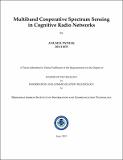Multiband cooperative spectrum sensing in cognitive radio networks
Abstract
Spectrum Sensing forms one of the most important functions of Cognitive Radio operation. Energy detection is a less complex spectrum sensing technique which does not need knowledge of Primary User (PU) signal. An Energy detection based Spectrum Sensing technique in frequency domain is discussed, which uses a Likelihood Ratio Test (LRT) as test statistic. Multiband sensing is performed on the received sampled signal at the Cognitive users (CR). The received signal samples are first converted into frequency domain using Discrete Fourier Transform (DFT) using the Fast Fourier Transform (FFT) algorithm. Once in frequency domain the signal power is calculated in each of the sub-bands which is compared against a threshold calculated using the Neyman-Pearson criterion for a fixed Probability of False alarm (Pf ).
The Probability Density Function (Pdf) for the power of the signal in each of the subbands has been derived assuming the noise power level and the channel conditions are known to the receiver, using some estimation method. This Pdf is used to calculate the Likelihood ratio under the two hypothesis for signal presence and absence. This likelihood ratio is compared against the above derived threshold and the Primary User presence or absence is declared.
Cooperative detection is considered for improving the sensing performance. Cooperation utilizes the spatial diversity among the observations of different CR users. Hard and Soft fusion schemes are compared in terms of complexity and performance.
Collections
- M Tech Dissertations [923]

